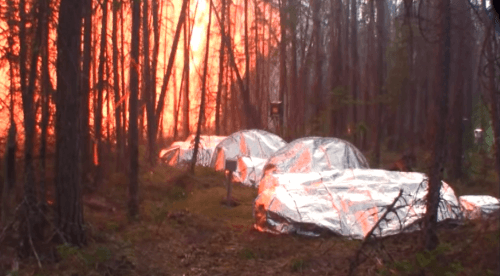The United States Forest Service may begin using fire shelters based on NASA's heat shield technology

Even after the most careful planning, wildland firefighters may suddenly find themselves surrounded by unexpected flames that can reach temperatures of 800 degrees Celsius and more. Without an escape route, they have no choice but to huddle inside fire shelters - small tents of reflective sheeting similar to aluminum foil - and hope the flames pass them by quickly.
In the summer of 2014, 19 firefighters evacuated the shelters provided to them at Yarnell Hill in Arizona, but the blaze was too strong, and no one survived. When scientists at NASA's Langley Research Institute learned of the disaster, they set about building a better shelter. They used the technology of an inflatable heat shield designed to withstand the hot temperatures that a spacecraft is exposed to when passing through the Earth's atmosphere (approximately 1000 to 2,700 degrees Celsius). In mid-April, the US Forest Service rained down flames on the shelters developed by NASA at the University of Alberta's experimental facility. The results have not yet been published, but previous tests looked promising. If this space technology turns out to be durable enough, it's possible that the firefighters will use it in the forests in the summer.
Regular fire tents have saved thousands of people over the past 50 years. But the incident at Yarnell Hill proved that "the shelters don't stand up to the high heat of direct flames," says NASA thermal scientist Josh Foddy, who participated in the development of the prototype. But the material from which the heat shield is made can withstand such conditions. The thin sheet is embedded with pieces of graphite similar in size and shape to black peppercorns. When exposed to flames, the graphite causes an insulating layer of glass fibers to expand and create a "big, fluffy blanket," says Fudi. He calls this material "smart" because it only expands when exposed to high temperatures. Its lightness is very important, because firefighters fighting a forest fire have to walk a difficult route and cannot carry cumbersome and heavy equipment.
If this technology is found to be effective, the timing will be excellent. Wildfires are burning twice as much land today as they did 20 years ago because the climate is hotter and drier, says Forest Service ecologist V. Matt Jolly. "This means that firefighters are exposed to more fire today than at any other time."
